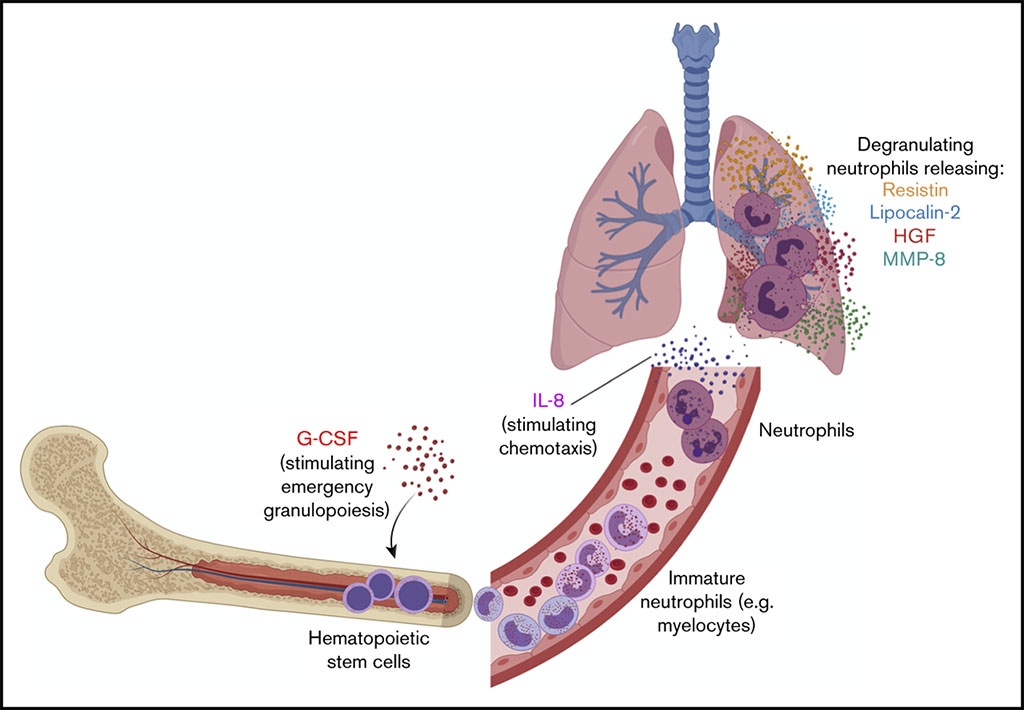Blood Tests Offer Early Indicator of Severe COVID-19
By LabMedica International staff writers
Posted on 09 Mar 2021
For most patients, COVID-19 manifests as an upper respiratory tract infection that is self-limited. However, the progression of COVID-19 in a large subset of patients to respiratory distress, multiorgan failure, and death has resulted in an enormous global impact. Posted on 09 Mar 2021
Previously, a few laboratory studies had identified possible indicators of severe COVID-19, including D-dimer levels, a measure of blood coagulation, and levels of proteins known as cytokines, which are released as part of inflammatory responses in the body.

Image: Schematic diagram of a neutrophil activation signature predicting critical illness and mortality in COVID-19 (Photo courtesy of Yale School of Medicine).
A multidisciplinary team of medical scientists at Yale School of Medicine (New Haven, CT, USA) conducted a study of 49 adult patients admitted to Yale-New Haven Hospital between 13 and 24 April, 2020 with a confirmed diagnosis of COVID-19 via polymerase chain reaction (cross-sectional cohort). The team also analyzed blood samples obtained longitudinally on days 1 (within 24 hours), 4, and 7 of hospitalization from a separate cohort of 23 consecutive adult patients admitted for treatment of laboratory-confirmed COVID-19 between 23 and 28 May 2020 who remained hospitalized until at least day 4 (longitudinal cohort).
Biomarker profiling analyses were conducted at Eve Technologies (Calgary, AB, Canada). For the cross-sectional cohort, the following assays were performed: Human Cytokine 71-Plex, Human Complement Panels 1 and 2, Human SAA & ADAMTS13, and Human Adipokine 5-Plex. For the longitudinal cohort, the following assays were performed: Human Cytokine 48-Plex, Human Complement Panel 1, Human Adipokine 5-Plex, and Human MMP 9-Plex and TIMP 4-Plex. For confirmation, RETN levels were also measured by enzyme-linked immunosorbent assay (ELISA) (R&D Systems, Minneapolis, MN, USA).
The scientists identified a prominent signature of neutrophil activation, including resistin, lipocalin-2, hepatocyte growth factor, interleukin-8, and granulocyte colony-stimulating factor, which were the strongest predictors of critical illness. Evidence of neutrophil activation was present on the first day of hospitalization in patients who would only later require transfer to the intensive care unit, thus preceding the onset of critical illness and predicting increased mortality. All COVID-19 patients who were admitted or transferred to the ICU had elevated neutrophil activation markers, while these biomarkers remained low for patients who never developed severe illness. None of the patients with lower neutrophil biomarker levels died.
Hyung J. Chun, MD, FAHA, an associate professor of medicine and lead author of the study, said, “If a diagnostic test for these biomarkers could be ordered early, it could give us a better sense of who is more likely to become critically ill and will benefit from a higher level of care and consideration for therapies that affect the immune system early on in their hospitalization. Many of these drugs do carry potential side effects, and these tests may help identify those patients who would benefit the most.”
The authors concluded that their study highlights a central role for neutrophil activation in the pathogenesis of severe COVID-19, which may help guide the development of new therapeutic strategies and more accurate predictive markers of severe disease. The study was published on February 26, 2021 in the journal Blood Advances.
Related Links:
Yale School of Medicine
Eve Technologies
R&D Systems













